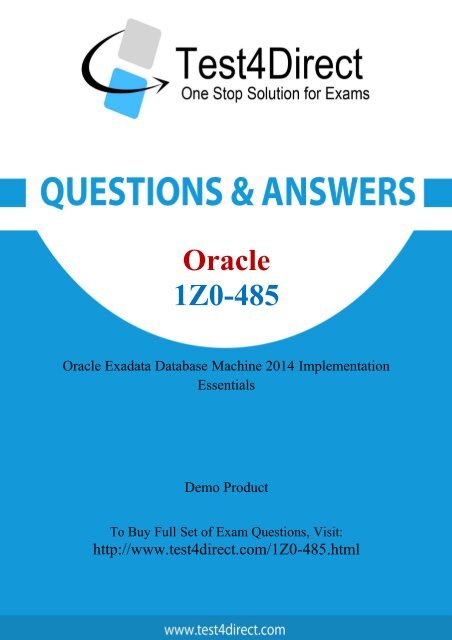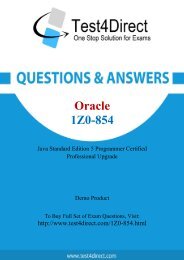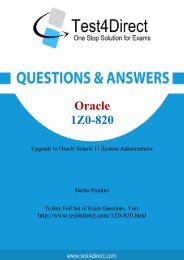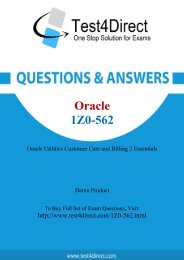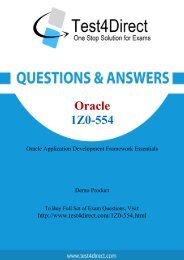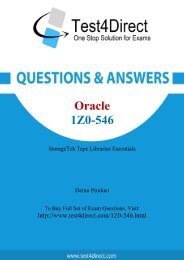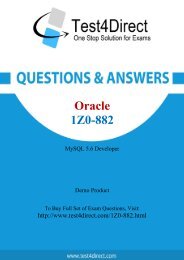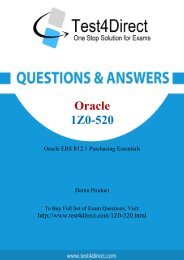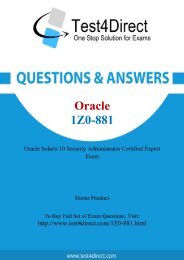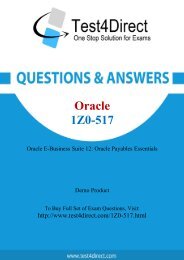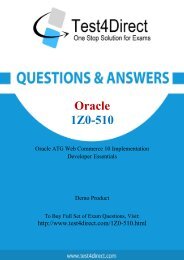1Z0-485 Exam BrainDumps are Out - Download and Prepare
Test4Direct provides latest PDF questions of Oracle 1Z0-485 exam. You have an opportunity to pass the Oracle 1Z0-485 exam in one go. Test4Direct is most accurate source to prepare Oracle 1Z0-485 exam as your success will become site’s responsibility after purchasing 1Z0-485 exam product. There are also lots of discounts and promotion offers that you can avail. Let’s try a free demo http://www.test4direct.com/1Z0-485.html
Test4Direct provides latest PDF questions of Oracle 1Z0-485 exam. You have an opportunity to pass the Oracle 1Z0-485 exam in one go. Test4Direct is most accurate source to prepare Oracle 1Z0-485 exam as your success will become site’s responsibility after purchasing 1Z0-485 exam product. There are also lots of discounts and promotion offers that you can avail. Let’s try a free demo http://www.test4direct.com/1Z0-485.html
Create successful ePaper yourself
Turn your PDF publications into a flip-book with our unique Google optimized e-Paper software.
Oracle<br />
<strong>1Z0</strong>-<strong>485</strong><br />
Oracle Exadata Database Machine 2014 Implementation<br />
Essentials<br />
Demo Product<br />
To Buy Full Set of <strong>Exam</strong> Questions, Visit:<br />
http://www.test4direct.com/<strong>1Z0</strong>-<strong>485</strong>.html
Question: 1<br />
Exadata Database Machine offers an Intelligent Platform Management Interface for the various<br />
components in the Exadata product. Which option is true?<br />
A. IPMI can be used to remotely start <strong>and</strong> stop servers.<br />
B. IPMI can be used to remotely log in to the operating system.<br />
C. IPMI comm<strong>and</strong>s can be executed by using SNMP traps.<br />
D. IPMI settings can be secured by backing up the Oracle Linux installation on the storage system.<br />
Question: 2<br />
Question: 3<br />
Answer: A<br />
Explanation:<br />
IPMI – short for Intelligent Platform Management Interface - is an interface st<strong>and</strong>ard that allows<br />
remote management of a server from another using st<strong>and</strong>ardized interface. The servers in the<br />
Exadata Database Machine follow that. It’s not an Exadata comm<strong>and</strong> but rather a general Linux one.<br />
To power on a cell or database server, issue this from another server:<br />
# ipmitool -H prolcel01-ilom -U root chassis power on<br />
To stop a server, use the shutdown comm<strong>and</strong>. To stop immediately <strong>and</strong> keep it down, i.e. not reboot,<br />
execute:# shutdown -h -y now<br />
Which is the best location to point your customer to, for finding the latest Exadata patches?<br />
A. owner's guide<br />
B. Patch database in MyOracle Support<br />
C. MyOracle Support note 888828.1<br />
D. MyOracle Support for database patches, ULN for OS patches, <strong>and</strong> Sun Support for Server <strong>and</strong><br />
InfiniB<strong>and</strong> patches.<br />
Answer: B<br />
Explanation:<br />
Before starting, we would like to sh<strong>are</strong> <strong>and</strong> note here two documents from My Oracle Support, aka<br />
metalink. These notes must be the first place that you need to go to review before patching the<br />
Exadata environment.<br />
* (B) Database Machine <strong>and</strong> Exadata Storage Server 11g Release 2 (11.2) Supported Versions<br />
(Doc ID. 888828.1)<br />
- This is for the second <strong>and</strong> third generation (V2 <strong>and</strong> X2) for Oracle Exadata, using Sun hardw<strong>are</strong>.<br />
* Database Machine <strong>and</strong> Exadata Storage Server 11g Release 1 (11.1) Supported Versions (Doc ID.<br />
835032.1)<br />
* - This is for the first generation (V1) for Oracle Exadata, using HP hardw<strong>are</strong>.<br />
A customer has three databases named CC. FIN, <strong>and</strong> DW. The CC database is for their CallCenter.
Even a slight decrease in the response time of the database would mean more people "on hold" in<br />
their data center. The orders received through the CallCenter <strong>are</strong> stored in the Finance (FIN)<br />
database. Both databases, CC <strong>and</strong> FIN, serve as sources for the Data W<strong>are</strong>house (DW) database. All<br />
databases use the same Automatic Storage Management (ASM) diskgroup <strong>and</strong> therefore, the same<br />
physical disks on Exadata storage. The customer wants to dynamically control the resources that <strong>are</strong><br />
available for the CallCenter database because this has direct impact on their operations? Which<br />
option should be implemented?<br />
A. DBRM on the CC database<br />
B. DBRM on all the databases<br />
C. IORM, because DBRM cannot be changed for an existing session<br />
D. IORM <strong>and</strong> DBRM<br />
Question: 4<br />
Question: 5<br />
Answer: B<br />
Explanation:<br />
Using the Database Resource Manager, you can:<br />
Distribute available processing resources by allocating percentages of CPU time to different users <strong>and</strong><br />
applications. In a data w<strong>are</strong>house, a higher percentage may be given to ROLAP (relational on-line<br />
analytical processing) applications than to batch jobs.<br />
Consider the following softw<strong>are</strong> changes that <strong>are</strong> performed manually on a Linux server:<br />
1. Changes for Linux kernel firewall configuration<br />
2. Changes for custom performance monitoring tools<br />
3. Changes for security scan tools<br />
4. Changes for Linux system performance optimization<br />
Which of the softw<strong>are</strong> changes listed <strong>are</strong> permitted on Exadata Storage Servers?<br />
A. 1, 2, 3, <strong>and</strong> 4<br />
B. only 3 '<br />
C. none<br />
D. only 2<br />
E. only 1 <strong>and</strong> 2<br />
F. only 2 <strong>and</strong> 3<br />
Answer: E<br />
Explanation:<br />
1: The Storage Server Patch is responsible for keeping our cell nodes always up-todate, fixing possible<br />
problems, <strong>and</strong> this patch includes different component patches, like kernel patches, firmw<strong>are</strong>,<br />
operation system, etc… for the Storage Server.<br />
Incorrect:<br />
3,4: security scan tools changes <strong>and</strong> Linux system performance optimization changes would be on<br />
the database server.<br />
Which two statements <strong>are</strong> true about enabling write-back flash cache?
A. When enabling write-back flash cache in a non rolling manner, it is important to ensure that<br />
asmdeactivatonoutcome is set to YES <strong>and</strong> asmModestatus is set to ONLINE for all grid disks.<br />
B. Before using write-back flash cache, you need to verify the minimum required versions.<br />
C. Before write back-flash cache is enabled, you need to drop the Flash Cache first.<br />
D. The setting flashCacheMode should be set to writeback by updating cellinit.ora <strong>and</strong> restarting<br />
cellsrv.<br />
E. When enabling write-back flash cache in a rolling manner, dcli should be used to inactivate the<br />
grid disks on all cells first.<br />
Question: 6<br />
Answer: B,C<br />
Explanation:<br />
B: Exadata storage version 11.2.3.2.1 is the minimum version required to use this write back flash<br />
cache option.<br />
C: Steps for Enabling Write back flash cache:<br />
First of all, you don’t need the stop CRS or database (This is ROLLING method) ,you can do it cell by<br />
cell.<br />
* drop flashcache<br />
* Be sure asmdeactivationoutcome is YES is before disabling grid disk<br />
Consider the following setup:<br />
User A1 belongs to resource group High on Database A<br />
User B2 belongs to resource group Low on Database B<br />
User C3 is a user on Database C without any DBRM setup.<br />
DBRM setup:<br />
Database A: Resource group High gets 80% <strong>and</strong> Low gets 20%.<br />
Database B: Resource group High gets 60% <strong>and</strong> Low gets 40%.<br />
IORM setup:<br />
Database A: Sh<strong>are</strong>=20, limit=5<br />
Database B: Sh<strong>are</strong>=30, limit=10<br />
Database C: 5 sh<strong>are</strong>s<br />
Total number of sh<strong>are</strong>s in the IORM setup = 100<br />
What percent of I/O will each database user theoretically be using when the Exadata storage unit I/O<br />
throughout is used 100% <strong>and</strong> no other databases but A, B, <strong>and</strong> C <strong>are</strong> running?<br />
A. Al = 36%, B2=18%, <strong>and</strong> C3=9%<br />
B. Al = 33%, B2=33%, <strong>and</strong> C3=33%<br />
C. AI = 10%, B2=5%, <strong>and</strong> C3=20%<br />
D. Al = 8%, B2=12%, <strong>and</strong> C3=5%<br />
E. Al = 5%, B2=10%, <strong>and</strong> C3=85%<br />
Answer: E<br />
Explanation:<br />
IORM setup limits Database A to 5%, <strong>and</strong> Database B is limited to 10%, while Database C has not<br />
IORM limit.<br />
Not that the resource groups <strong>are</strong> for CPU allocation.
Question: 7<br />
Consider this CellCLI comm<strong>and</strong>:<br />
CellCLI> CREATE GRIDDISK ALL HARDDISK PREFIX=data, size=423G;<br />
Which two statements describe what happens when you execute this comm<strong>and</strong>?<br />
A. It creates one 423 GB grid disk on the first available cell hard disk.<br />
B. It creates one 423 GB grid disk on each available cell hard disk.<br />
C. It creates grid disks on the outermost 423 GB that is available on each hard disk.<br />
D. It creates grid disks on the innermost 423 GB that is available on each hard disk.<br />
E. It creates an Exadata Smart Flash Cache on all flash drives.<br />
Question: 8<br />
Answer: B,C<br />
Explanation:<br />
* <strong>Exam</strong>ple:<br />
CellCLI> create griddisk all harddisk prefix=temp_dg, size=570G<br />
This comm<strong>and</strong> will create 12 Griddisks, each of 570G in size from the outer (fastest) sectors of the<br />
underlying Harddisks. It fills up the first 2 Celldisks entirely, because they have just 570G space<br />
free – the rest is already consumed by the OS partition.<br />
You get a Host Unreachable error when you attempt to connect to a server through a network<br />
terminal comm<strong>and</strong> line. What <strong>are</strong> two other ways in which you can connect?<br />
A. Use the ILOM Web GUI.<br />
B. Use the dcli comm<strong>and</strong> at the root prompt on a database node.<br />
C. Attach a terminal device to the back panel of the server with a serial cable.<br />
D. Connect by using SQL *Plus.<br />
E. Log in as root on the database node using the Net1 IP address.<br />
Answer: A,C<br />
Explanation:<br />
In addition to gaining shell access via SSH to manage your Exadata servers, you can also access them<br />
from the Integrated Lights <strong>Out</strong> Management (ILOM) console or KVM console.<br />
<strong>and</strong> should typically not require modifications unless you have changed network information inside<br />
your database<br />
machine.<br />
Note: A KVM switch (with KVM being an abbreviation for "keyboard, video <strong>and</strong> mouse") is a<br />
hardw<strong>are</strong> device that allows a user to control multiple computers from one or more[1] keyboard,<br />
video monitor <strong>and</strong> mouse. Although multiple computers <strong>are</strong> connected to the KVM, typically a<br />
smaller number of computers can be controlled at any given time
THANKS FOR TRYING THE DEMO OF OUR PRODUCT<br />
Visit Our Site to Purchase the Full Set of Actual <strong>1Z0</strong>-<strong>485</strong> <strong>Exam</strong> Questions With Answers.<br />
http://www.test4direct.com/<strong>1Z0</strong>-<strong>485</strong>.html<br />
We Also Provide Practice <strong>Exam</strong> Softw<strong>are</strong> That Simulates Real <strong>Exam</strong> Environment And Has<br />
Many Self-Assessment Features. <strong>Download</strong> Free Product Demo From:<br />
http://www.test4direct.com/<strong>1Z0</strong>-<strong>485</strong>.html<br />
Money Back Guarantee<br />
Check <strong>Out</strong> Our Customer Testimonials


